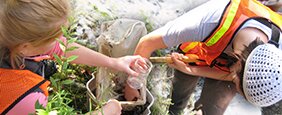OVERVIEW
Students develop a plan for their research project. The guiding question for this activity is: How will you go about collecting evidence to support or refute your hypothesis?
GETTING READY
Materials
Students will need to assemble their background information, questions, notes about the field site and scientific claims.
(It would be better yet to have students keep these documents together in a folder for the project.)
List (on the board, web site, or handout) the materials that are available to the students. See the extensive list of equipment in Essential Activity: Preparing for Sampling
ACTIVITY PROCEDURE
Thinking about samples
Things we can sample:
- Invertebrates – dragonfly larva, other insects, worms, snails, etc.
- Fish muscle or other tissue (with permission)
- Plants – floating or submerged, or plant parts
- Soil
Things we can measure about those samples:
- mass or weight
- size (length, other measures)
- number of things collected
- species abundance
- species richness
- species or type (e.g., deciduous versus coniferous plants; species of insects)
- mercury in the substance/organism(s)
- higher trophic level organisms in the study area (bird surveys, mammal tracking)
Doing the Activity
Finalize the research plan by answering the plan's basic who, what, where, when, why and how. The “why” is the scientific claim.
- Each group should reiterate its claim.
- They should answer their research question and claim in a general sense (if the question is "Does the amount of mercury depend on where the invertebrates live?" The claim might be “Aquatic invertebrates that live in sediments have greater mercury than those that swim around in the water because they are more sedentary. ”)
- After reiterating their claim they should make a general statement of how they can support their claim: “Find some invertebrates that live in each place and test them for mercury”.
- Craft that general approach into a workable study plan – iron out all the details. Troubleshoot the study plan:
For example (for the claim above)-
- What type of invertebrate should you collect? Should they be about the same size?
- What else would you need to know about the invertebrates? What do they eat? What eats them? Do they live in the same art of the stream or lake?
- Who will collect the samples?
- How will they be collected? How many invertebrates will you collect? Do you want to know how much mercury is in animals from different types of sediment? Does that matter in answering your specific scientific claim?
There are more questions. Many more will arise during the process and will need to be addressed. Students should take notes and keep track of how they will address all of the issues.
If it helps, draw it out!
REFLECTION/ASSESSMENT IDEAS
Peer review:
Have each group present its research plan to the class, and encourage feedback and questions from the other groups.
Give 5/Take 5: Hand out Post-It notes and have each person, or group, write out five "Things to consider..." for each other group...
Good prompts:
- "How will you..."
- "What about..."
Have each group revise their study plan to incorporate five of the recommendations.
If the project is going to be a class project, follow with a discussion of pros and cons of each group’s presentation, and formulate a coordinated plan for sampling, using a collaborative approach where the best of each group’s methods are combined.
Each group should then write a brief statement on the changes they made to their study plan, and why they made them.
EXTENSION IDEAS
The information the students have put together to this point can be called a research proposal. Students can now be asked to put together a more formal proposal. A research proposal is a document that describes the plan for the project. It makes the case for the proposed study and approach. (Scientists frequently write research proposals and other groups of scientists or people from science agencies judge those proposals to decide which ones deserve funding.)
Once the proposals are completed, students will then have the opportunity to review their peers' proposals with the goal of making constructive, collaborative improvements. Remember, there’s no right or wrong approach to a research project, but the choices students make will determine how they can interpret their results. Alternatively, the teacher or the cooperating scientist can review and make comments on everyone’s proposal.
The following are the general sections that should be included in a research proposal and some questions to answer in each section. Here you’ll think about, collect, and enter information about your project.
- Research project title: Give your project a name
- Introduction: (3‐4 sentences) Why do we care about mercury in the environment? In organisms? How does mercury get into the environment at your study site? How does it get into organisms and move through food webs?
- Hypothesis: (1‐2 sentences) “We hypothesize that…”
- Methods: This section summarizes all the decisions made above – who, what, when, where how?
- Results and discussion: (2‐3 sentences)
- What do you think you might find? Maybe you have some ideas because you already have some data.
- What will your data mean? Two sentences:
- Start with: “If the hypothesis is supported, then… “
- Start with: “If the hypothesis is not supported, then… “
- References: If you cite (or mention in your proposal) any web sites or articles where you found information (such as your statements about how mercury gets into people, or if you’re using someone else’s methods), you need to list them here.

 Acadia Learning brings scientists, teachers, and students together in partnerships that result in useful research and effective science education.
Acadia Learning brings scientists, teachers, and students together in partnerships that result in useful research and effective science education.